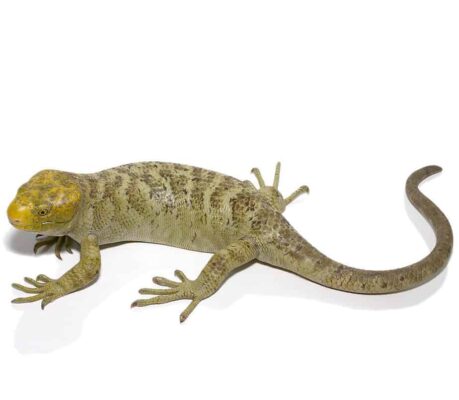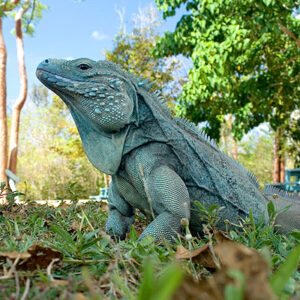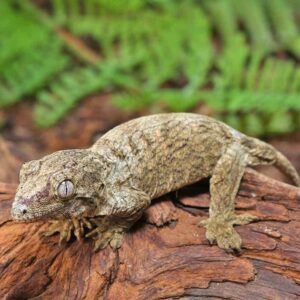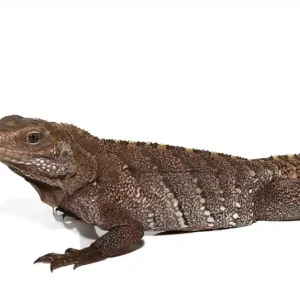Keylime Monkey Tail Skink For Sale
$1,199.99
WE HAVE KEYLIME MONKEY TAIL SKINK FOR SALE. HERE ARE SOME HIGHLIGHTS:
- Corucia zebrata
- Farm Bred
- Approximately 14 – 17 Inches In Length From Head To Tail
- Adults Can Reach Up To Lengths Of 32 Inches In Total
- These Are Voracious Foragers Feeding On Fresh Fruits And Vegetables
FUN FACTS!
- These Skinks Have Prehensile Tails Meaning They Can Grip And Grab Things With Their Tails
- Gorgeous Animals Not Frequently Seen Here At Underground Covered In Rich Green And Brown Patterns Giving Them Perfect Camouflage
- Naturally Occurring Out Of The Solomon Islands
- Females Are Viviparous Meaning That They Bear Live Young
- With Proper Care These Can Live More Than 20 Years In Captivity
Description
The Keylime Monkey Tail Skink, scientifically known as Corucia zebrata keylima, is a captivating reptile that has garnered significant interest among enthusiasts and researchers alike. This unique skink is a subspecies of the larger Solomon Islands Monkey Tail Skink and is distinguishable by its striking coloration and physical attributes.
Physically, the Keylime Monkey Tail Skink is noted for its vibrant green and yellow scales, which create a keylime-like appearance, giving the skink its common name. This distinctive coloration not only serves an aesthetic function but also provides effective camouflage within its natural habitat. The skink possesses a prehensile tail, which it uses adeptly for climbing and grasping branches, an attribute that underscores its arboreal lifestyle.
One of the most fascinating aspects of the Keylime Monkey Tail Skink is its social behavior. Unlike many other skink species that are predominantly solitary, this species exhibits a high degree of social interaction. They are known to form small family groups, engaging in cooperative behaviors such as mutual grooming and communal basking. This social structure is quite rare among reptiles, making the Keylime Monkey Tail Skink a subject of particular interest for behavioral studies.
The popularity of the Keylime Monkey Tail Skink among reptile enthusiasts can be attributed to its unique characteristics and relatively docile nature. Its vivid coloration, coupled with its interactive behavior, makes it a favorite in the reptile-keeping community. Additionally, this skink’s ability to thrive in captivity under proper care further enhances its appeal.
Overall, the Keylime Monkey Tail Skink is a remarkable reptile that stands out for its distinctive physical traits, engaging social behaviors, and popularity among hobbyists. This introductory overview sets the stage for a deeper exploration into the habitat, diet, and conservation efforts surrounding this intriguing species.
Habitat and Natural Environment
The Keylime Monkey Tail Skink, a unique and captivating reptile, is predominantly found in the lush and diverse landscapes of the Solomon Islands. This archipelago, nestled in the southwestern Pacific Ocean, provides the ideal environment for the skink’s thriving population. The geographical conditions of these islands are varied, encompassing dense tropical forests, humid woodlands, and rocky outcroppings, all of which play a crucial role in supporting the skink’s intricate lifestyle.
Primarily, the Keylime Monkey Tail Skink is associated with the dense, verdant canopies of tropical rainforests. These forests offer an abundance of foliage and tree trunks, which are essential for the arboreal nature of the skink. The dense vegetation provides ample hiding spots and an abundance of food resources, such as leaves, fruits, and small invertebrates. The high humidity and stable temperatures within these forests are also vital, as they create a microclimate that supports the skink’s physiological needs, including skin hydration and thermoregulation.
In addition to rainforests, the Keylime Monkey Tail Skink can also be found in more open woodlands and rocky areas. These environments, while less dense, still offer the necessary structural elements such as logs, rocks, and sparse vegetation. These areas allow the skink to exhibit its climbing abilities and provide essential basking spots to regulate their body temperature. The varied terrain of rocky outcroppings also aids in protection from predators, giving the skink numerous crevices and spaces to retreat into when threatened.
Overall, the natural habitat of the Keylime Monkey Tail Skink is characterized by its diversity and complexity. The varied ecological niches within the Solomon Islands not only support the skink’s survival but also highlight the adaptability and resilience of this species. Understanding these habitats is crucial for conservation efforts, ensuring that the Keylime Monkey Tail Skink can continue to thrive in its natural environment.
Diet and Feeding Habits
The Keylime Monkey Tail Skink, a remarkable reptile found predominantly in the lush rainforests of the Solomon Islands, has a diet that reflects its arboreal lifestyle. In the wild, these skinks primarily consume a variety of plant material, including leaves, flowers, and fruits. Their preference for such a diet ensures they receive an optimal balance of nutrients necessary for their health and wellbeing. The high fiber content in their diet aids digestion and maintains a healthy gut, while the array of vitamins and minerals from diverse plants supports robust immune function and overall vitality.
In their natural habitat, Keylime Monkey Tail Skinks are often observed foraging during the early morning or late afternoon, times when the foliage is moist and tender. This behavior not only helps them avoid the heat of the day but also maximizes their intake of fresh, nutrient-rich food sources. Occasionally, they may supplement their diet with small insects or other invertebrates, providing an additional protein boost that is particularly beneficial during growth or breeding periods.
For those who keep Keylime Monkey Tail Skinks in captivity, replicating their natural diet is crucial for their health. Fresh leafy greens such as collard greens, dandelion leaves, and hibiscus flowers should form the bulk of their diet. Additionally, fruits like papaya, mango, and berries can be offered in moderation to mimic their wild foraging habits. Providing a variety of these foods ensures a well-rounded diet that closely resembles what they would encounter in their natural environment.
It is essential to avoid feeding skinks foods that are high in oxalates, such as spinach and beet greens, as these can inhibit calcium absorption and lead to health issues. Supplementing their diet with calcium and vitamin D3 is also recommended, particularly for individuals that do not receive adequate natural sunlight. By adhering to these dietary guidelines, keepers can promote the longevity and wellbeing of their Keylime Monkey Tail Skinks, ensuring they thrive both in captivity and in the wild.
Behavior and Social Structure
The Keylime Monkey Tail Skink exhibits a fascinating array of behaviors that highlight its adaptability and social nature. In the wild, these skinks are known for their territoriality, often marking their territory with scent glands to ward off potential intruders. Males are particularly aggressive during the breeding season, displaying dominance through physical posturing and occasional skirmishes. These territorial disputes are usually non-lethal but serve as a critical component in establishing hierarchical structures within their habitat.
Social interactions among Keylime Monkey Tail Skinks are complex and varied. These skinks are generally solitary creatures, but they do engage in social bonding, especially during mating rituals. Courtship involves a series of intricate behaviors, including tail waving, body arching, and gentle nipping, which help in pair formation and successful mating. Once a pair bond is established, they may remain close, with the male often seen guarding the female.
One of the unique behaviors of the Keylime Monkey Tail Skink is its exceptional climbing ability. Equipped with strong limbs and a prehensile tail, these skinks are agile climbers, often scaling trees and other vertical structures to escape predators or search for food. This arboreal lifestyle is equally evident in captivity, where they thrive in environments that replicate their natural habitat, complete with branches and climbing spaces.
Burrowing also plays a significant role in the life of a Keylime Monkey Tail Skink. In the wild, they dig burrows to create safe havens, protect themselves from extreme weather, and lay eggs. In captivity, providing substrates that allow for burrowing can significantly enhance their well-being, as it aligns with their innate behaviors.
Interactions with other species are generally limited, but Keylime Monkey Tail Skinks can coexist with other non-aggressive reptile species under controlled conditions. Their behavior in captivity mirrors their wild counterparts, although they may exhibit more docile and predictable habits due to regular human interaction and a stable environment.
Reproduction and Lifespan
The reproductive cycle of the Keylime Monkey Tail Skink is a fascinating aspect of its biology. These skinks exhibit a unique reproductive pattern characterized by a distinct mating season that typically occurs during the warmer months. The mating season is marked by increased activity and interactions among individuals as they seek out potential mates. Once a successful pairing occurs, the gestation period for the female Keylime Monkey Tail Skink lasts approximately 6 to 8 months. During this time, the female undergoes significant physiological changes as she prepares to give birth.
Keylime Monkey Tail Skinks are viviparous, meaning they give birth to live young rather than laying eggs. On average, a female will produce one to two offspring per reproductive cycle. The number of offspring can be influenced by various factors, including the female’s age, health, and environmental conditions. The newborn skinks are relatively well-developed and are capable of independent movement shortly after birth. They remain with the mother for a brief period, during which they receive essential care and protection.
The lifespan of the Keylime Monkey Tail Skink can vary significantly between wild and captive environments. In the wild, these skinks typically live for about 10 to 15 years. However, various factors such as predation, habitat quality, and availability of food can influence their longevity. In captivity, where they are provided with optimal care, nutrition, and protection from predators, Keylime Monkey Tail Skinks can live longer, often reaching up to 20 years or more. Proper husbandry practices, including maintaining appropriate temperature and humidity levels, are crucial to ensuring their long-term health and longevity in a captive setting.
Conservation Status and Threats
The Keylime Monkey Tail Skink, an intriguing reptile known for its distinctive prehensile tail, is currently classified under the category of “vulnerable” by conservation authorities. This status underscores the pressing need for immediate attention to safeguard its dwindling population. The primary threats to the Keylime Monkey Tail Skink stem from habitat destruction, climate change, and predation.
Habitat destruction, primarily due to deforestation and land development, plays a significant role in the species’ decline. As tropical forests are cleared for agricultural purposes and urban expansion, the skinks lose their natural habitat, leading to a reduction in their population. The loss of tree cover not only diminishes their living space but also affects their food sources, making survival increasingly challenging.
Climate change further exacerbates the situation. Shifts in temperature and precipitation patterns disrupt the delicate balance of the skink’s ecosystem. These changes can lead to alterations in the availability of food and water, which are critical for their sustenance. Additionally, extreme weather events, such as prolonged droughts or intense storms, can directly impact their habitat, causing further stress to the population.
Predation is another significant threat to the Keylime Monkey Tail Skink. Natural predators, such as birds of prey and larger reptiles, pose a constant danger. However, the introduction of non-native species, particularly domestic animals like cats and dogs, has intensified this threat. These invasive predators often hunt the skinks, contributing to their declining numbers.
To combat these threats, several conservation efforts are underway. Protected areas have been established to preserve the remaining habitats of the Keylime Monkey Tail Skink. Conservation organizations are also engaging in reforestation projects to restore degraded habitats. Additionally, initiatives to raise public awareness about the importance of this species and the threats it faces are crucial. These efforts aim to foster a sense of responsibility and encourage local communities to participate in conservation activities.
In conclusion, the survival of the Keylime Monkey Tail Skink hinges on concerted conservation efforts. By addressing habitat destruction, mitigating the impacts of climate change, and controlling predation, we can ensure the continued existence of this fascinating species for future generations.
Care and Maintenance in Captivity
Ensuring the health and well-being of Keylime Monkey Tail Skinks in captivity requires meticulous attention to habitat setup, temperature, humidity, and dietary needs. A well-maintained environment is crucial for these reptiles to thrive.
Firstly, the habitat should mimic the skink’s natural environment as closely as possible. A spacious terrarium, ideally measuring at least 4 feet by 2 feet by 4 feet, is essential. This enclosure should include both vertical and horizontal space, as these skinks are semi-arboreal and require ample climbing structures. Incorporate branches, vines, and secure platforms to facilitate their natural climbing behavior. Additionally, a substrate that retains moisture, such as coconut coir or reptile bark, should be used to maintain appropriate humidity levels.
Temperature and humidity control are paramount. The ambient temperature within the enclosure should be maintained between 75-85°F, with a basking spot that reaches up to 95°F. Nighttime temperatures should not drop below 70°F. Humidity levels should be kept between 60-80%, which can be achieved through regular misting and the use of a humidity-retentive substrate. Monitoring these levels with reliable thermometers and hygrometers is advised.
Feeding Keylime Monkey Tail Skinks involves offering a varied diet that includes fresh fruits, vegetables, and occasional protein sources such as insects or boiled eggs. Leafy greens, squash, and berries are particularly beneficial. Supplements, including calcium and vitamin D3, should be provided to prevent deficiencies and promote bone health.
Handling should be approached with care and patience. These skinks can become stressed if handled improperly or too frequently. Gentle, consistent interaction will help them become accustomed to human presence, making the process less stressful for both the skink and the caregiver.
Regular health checks are essential to identify and address common health issues such as respiratory infections, metabolic bone disease, and parasites. An annual visit to a reptile veterinarian is recommended to ensure the skink remains in optimal health.
By adhering to these guidelines, caregivers can create a nurturing environment that supports the physical and psychological well-being of Keylime Monkey Tail Skinks, ensuring they lead healthy and stress-free lives in captivity.
Interesting Facts and Myths
The Keylime Monkey Tail Skink, scientifically known as Corucia zebrata, is a species that captivates enthusiasts with its unique traits and storied history. Contrary to common belief, these skinks are not aggressive by nature. They possess a docile temperament, making them a fascinating subject for both researchers and hobbyists. One remarkable ability of the Keylime Monkey Tail Skink is its prehensile tail, which functions almost like an additional limb. This adaptation is crucial for climbing and maintaining balance in their arboreal habitats.
Historically, the Keylime Monkey Tail Skink has been surrounded by myths and misconceptions. One such myth is the belief that these skinks can regenerate their tails. While some reptiles have this capability, the Keylime Monkey Tail Skink does not. However, their strong tails play an essential role in their survival, providing stability and aiding in their movement through dense foliage. Additionally, these skinks are often mistaken for being solitary creatures. In truth, they are highly social and exhibit complex social structures, often forming tight-knit family groups.
Culturally, the Keylime Monkey Tail Skink has found its place in various indigenous folklore. In some Pacific Islander traditions, these skinks are considered symbols of agility and resilience. Their ability to navigate through challenging environments is often revered and likened to overcoming life’s obstacles. Moreover, the unique appearance of the Keylime Monkey Tail Skink, with its striking green coloration and distinctive markings, has inspired numerous artistic representations, from traditional carvings to contemporary illustrations.
In conclusion, the Keylime Monkey Tail Skink is a species that defies many common misconceptions and offers a wealth of intriguing characteristics. From their prehensile tails to their social behaviors and cultural significance, these skinks provide a compelling subject for further exploration and appreciation.






